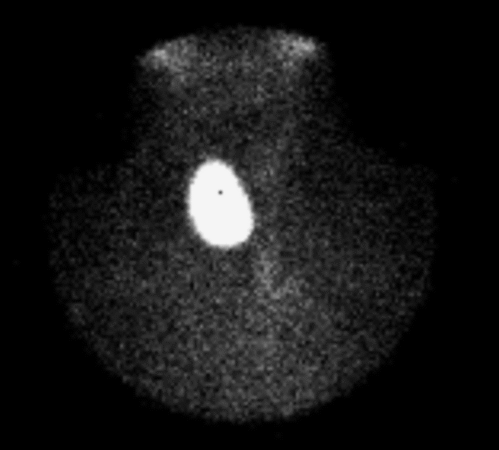Case Author(s): Jeff Chesnut, D.O. and Henry D. Royal, M.D. , 7/26/99 . Rating: #D1, #Q4
Diagnosis: Autonomous functioning toxic thyroid nodule
Brief history:
30 year old female with hyperthyoroidism and palpable left neck nodule.
Images:

Anterior image from a Tc-99m pertechnetate thyroid scan is shown.
View main image(tr) in a separate image viewer
View second image(tr).
Magnified view of the thyroid is shown.
Full history/Diagnosis is available below
Diagnosis: Autonomous functioning toxic thyroid nodule
Full history:
30 year old female internal medicine resident with hyperthyroidism and large
right neck nodule to palpation.
Radiopharmaceutical:
Tc-99m pertechnetate
Findings:
There is intense activity in a single large nodule in the right neck with
suppresion of the remainder of the thyroid gland.
Discussion:
Patients with solitary toxic nodules are often younger than patients with
multinodular toxic goiters. They are slightly more common in men, as opposed
to multinodular goiters in which sex prediliction is roughly equal.
In young people, surgery is often the treatment of choice for solitary
hyperfunctioning nodules, though radioiodine or percutaneous intranodular
injection of ethanol may also be used. I-131 therapy is used, however,
higher doses of radioiodine are required (15-25 mCi) as these nodules are
relatively radioiodine insensitive.
Followup:
The patient elected not to have surgery on this nodule. She was subsequently
treated with 15 mCi radioiodine.
Major teaching point(s):
1. Solitary hyperfunctioning nodules are most common in adolescents or
young adults with a slight male prediliction. This is in contrast to
multinodular toxic goiters which more often occur in older adults and have
no defininte sexual prediliction.
2. If the patient with solitary hyperfunctioning nodule is treated with
radioiodine, higher doses are required.
ACR Codes and Keywords:
References and General Discussion of Thyroid Scintigraphy (Anatomic field:Face, Mastoids, and Neck, Category:Metabolic, endocrine, toxic)
Search for similar cases.
Edit this case
Add comments about this case
Return to the Teaching File home page.
Case number: tr009
Copyright by Wash U MO

